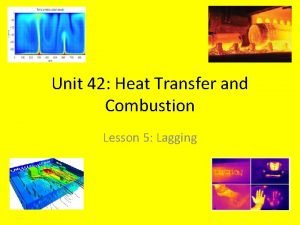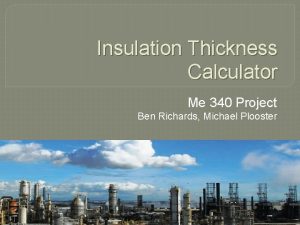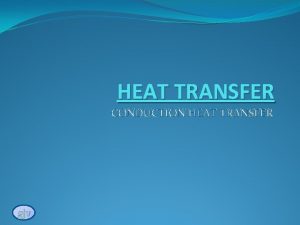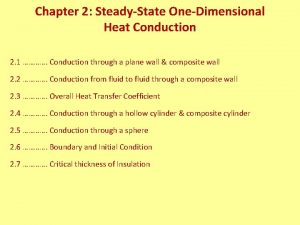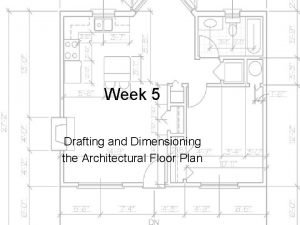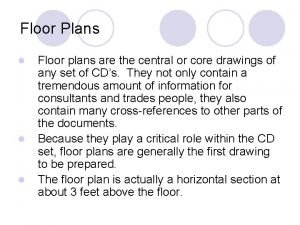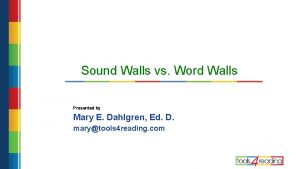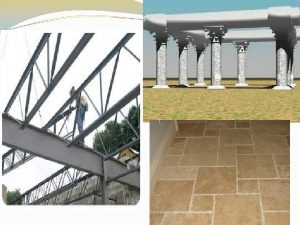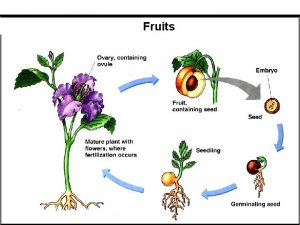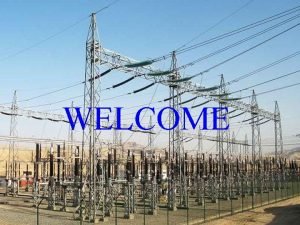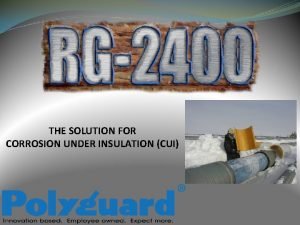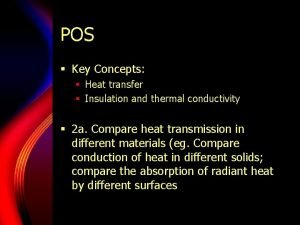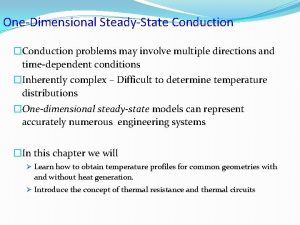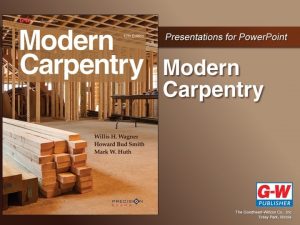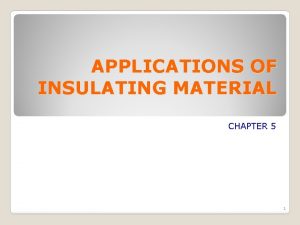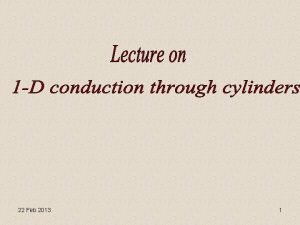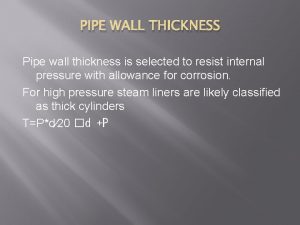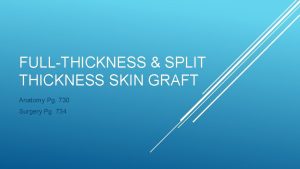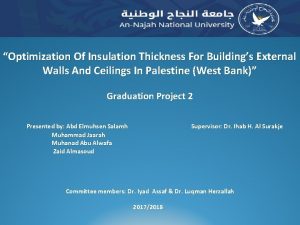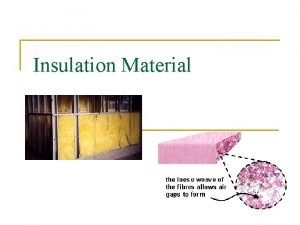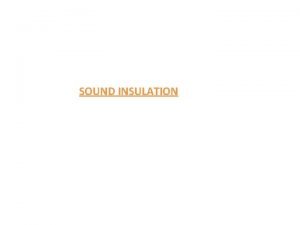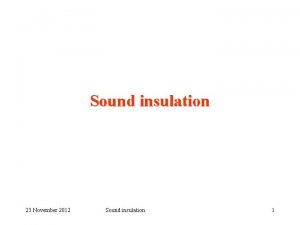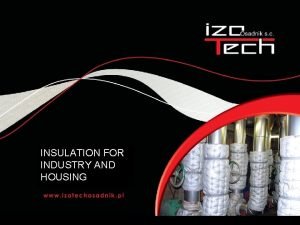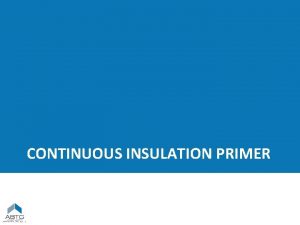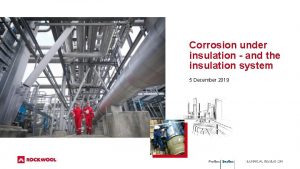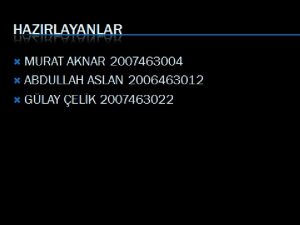NUMERICAL STUDY OF EFFECT OF WALL INSULATION THICKNESS
























- Slides: 24

"NUMERICAL STUDY OF EFFECT OF WALL INSULATION THICKNESS ON ENERGY PERFORMANCE FOR DIFFERENT CLIMATE REGION OF PALESTINE“ Prepared By: Majd qadous Wajeeh nase Supervised by : Dr. Ramez khaledy

Introduction • The project will apply on both heating and cooling system • The main problem that the project will treat is the loss of energy from the walls • the main objective is reduced energy consumption by use insulation material thickness • parameters: effect of wall orientation, life cycle and payback period • type of insulation materials are polystyrene and polyurethane

Introduction First, because Palestine has limited renewable sources of energy, there has to be a way to reduce energy consumption lost through the walls. Therefore, engineers resorted to a way to reduce energy consumption, which is insulation.

Introduction • insulation material it was found that the put of the insulating material reduces the energy lost, and when increase thickness of the insulation material then energy lost will decrease and the costs will increase.

Introduction Orientation of building At first, people did not take into account the direction of the walls, but with engineers it was found that the direction of the wall was a very important factor to provide as much energy as possible by absorbing as much of the sun as possible

LITRATURE REVIEW Effect of Wall Orientation. Saving Energy and Payback Period: Your logo

LITRATURE REVIEW Wall Orientation: Ozel, M. , (2011) the optimal insulation thickness for different walls orientations is different between the walls. The lower cooling load is provided for north facing wall while the lower heating load is provided for south-facing walls. The east and west orientation provide the same cooling and heating transmission load

LITRATURE REVIEW Wall Orientation: Al-Sanea, S. A. , et al. (2002) The south-facing wall is the most favorite orientation because the minimum heating load in Riyadh. Polystyrene is found to be the most economical type with an optimum thickness of 9. 3 cm.

LITRATURE REVIEW Life cycle and payback period: M. Ozel (2011) The optimum insulation thickness material of building walls for heating and cooling system between 2 and 8. 2 cm, the energy savings vary between 2. 78 and 102. 16 $/m 2, and the payback periods vary between 1. 32 and 10. 33 years.

LITRATURE REVIEW Life cycle and payback period: Hasan (1999) The payback period for polystyrene 1. 4 -2. 3 but the life cycle savings over 10 year is 8. 27 -19. 70($/�� 2)

METHODOLOGY

Degree day Heating degree day : DDh = (18. 3 - Ta)*Nh cooling degree day : DDc = (Ta+ 0. 026*SHG) heating and cooling degree day : ���� =(DDc / ������ )+(DDh / η)

Optimum insulation thickness Xopt for heating system by diesel : Xopt = [(86400 ∗ Cf ∗ DDh ∗ K ∗ PWF)/(Ci ∗ H ∗ η)] 1/2 - K*Rt Xopt for cooling system by electricity: Xopt = [(0. 024∗ Ce ∗ DDc ∗ K ∗ PWF)/(Ci ∗ cop)] 1/2 - K*Rt

Life cycle saving and payback period saving by diesel: Ct 1= 86400* PWF *Cf*DDh /(Rt∗H∗ η) Ct 2 = 86400*PWF*Cf*DDh [(Rt+(Xopt/K))/(H∗ 0. 7)] + Ci*Xopt saving = Ct 1 -Ct 2 cooling degree day : Ct 1= 0. 024 * PWF *Ce *DDc /(Rt∗cop) Ct 2 = 0. 024* PWF * Ce * DDc [(Rt+(Xopt/K))/(cop)] + Ci*Xopt saving = Ct 1 - Ct 2

Result & Discussion

Result & Discussion The optimum insulation thickness for cooling by electricity(Jericho) • • 8 electricity cost insulation cost total cost annual cost $/�� ^2 7 6 5 4 3 2 1 0 0 0, 01 0, 02 0, 03 0, 04 0, 05 insulation thickness, m Fig: Cost of cooling (south) for insulated buildings versus insulation thickness for Jerich. 0, 06

Result & Discussion The optimum insulation thickness for heating by diesel (Jericho) 35 insulation cost fuel cost total cost annual cost $/�� ^2 30 25 20 15 10 5 0 0 0, 03 0, 06 0, 09 0, 12 0, 15 0, 18 0, 21 0, 24 insulation thickness, m Fig : Cost of heating (diesel) for insulated buildings versus insulation thickness for Jericho.

Result & Discussion The optimum insulation thickness for cooling and heating by electricity(Jericho) The optimum insulation thickness for heating by electricity (Jericho)

Result & Discussion • life cycle and payback period for cooling by electricity (Jericho) life cycle and payback period for heating by electricity (Jericho)

Result & Discussion life cycle and payback period for heating and cooling by electricity (Jericho) life cycle and payback period for heating by diesel (Jericho)

Result & Discussion 0, 08 polystyerene polyurathene Insuation thickness , m 0, 07 0, 06 0, 05 0, 04 0, 03 0, 02 0, 01 0 0 2 4 6 8 PWF Optimum insulation thickness versus present worth factor for wall 1 heating electricity 10 12

Conclusion In conclusion ØWe have studied a number of knowledge in the literature review and we have obtained several results. The most important of these results when increasing the insulation thickness, we get less cooling and heating load and also according to research, it was found that the best insulation thickness in the process is 5 cm, Ø Using diesel for heating is better than electricity because the pay pack period and saving for diesel is better.

Future work ØIn our project, we calculated the best insulation in the West Bank, and we hope that in the future they will calculate the optimum insulation for the Gaza Strip, develop the Matlab program and search for new types of walls spread to calculate the best insulation Øit is necessary to study other influencing factors other than the orientation of the walls and save energy. For example, the effect of the arrangement of components on the thickness of the insulation and the effect of the glass should be studied, as well as the study of the insulation of the ceiling and the floor and do not study limited.

 Critical radius of insulation
Critical radius of insulation Insulation thickness calculation online
Insulation thickness calculation online What is critical radius of insulation
What is critical radius of insulation Critical thickness of insulation for cylinder
Critical thickness of insulation for cylinder Sempatap thermal solid wall insulation
Sempatap thermal solid wall insulation Floor plan dimensioning
Floor plan dimensioning Interior wall thickness
Interior wall thickness Sound walls for reading
Sound walls for reading Chris brown wall
Chris brown wall Half brick wall in stretcher bond
Half brick wall in stretcher bond Members used to carry wall loads over wall openings
Members used to carry wall loads over wall openings Pod fruit develops from
Pod fruit develops from North wall
North wall Dielectric absorption ratio ieee
Dielectric absorption ratio ieee Corrosion under insulation primer
Corrosion under insulation primer Conduction vs insulation
Conduction vs insulation Steady state heat conduction
Steady state heat conduction Thermal resistance formula
Thermal resistance formula Global specialised systems
Global specialised systems Foam plastic insulation
Foam plastic insulation Chapter 17 thermal and sound insulation
Chapter 17 thermal and sound insulation Insulating material used in transformer
Insulating material used in transformer Critical radius of insulation for cylinder
Critical radius of insulation for cylinder Overvoltage due to switching surges
Overvoltage due to switching surges Containment theory criminology
Containment theory criminology
